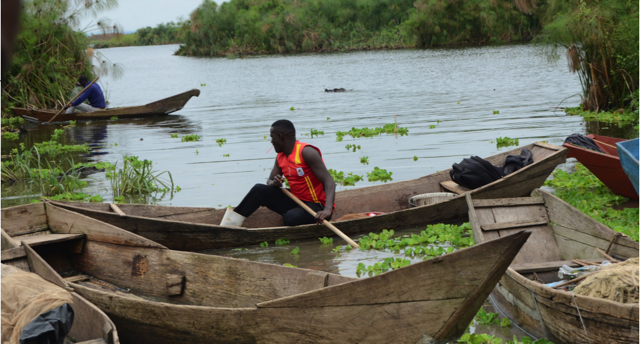
It is difficult to tell the exact number of fishermen on this lake. Six years ago, the last time the National Fisheries Resources Research Institute (NaFIRRI) registered fishermen on the lake, there were about 1,500 of them.
But Elijah Ssenyonjo, the fisheries officer for Mityana District told The Independent that it has about 470 registered fishermen, with about 340 being on the Mityana side of the lake. But, when you include the non-registered fishermen, it is possible that this lake has more than 1000 fishermen. He said he suspects there are even more fishermen on the lake since the COVID-19 pandemic hit the country last March.
Tebajanga’s story is quite similar to that of Ali Ssekiwunga who was born and raised in Katiko village, just 7km from Mityana town on the northeastern shores of the lake.
Ssekiwunga says as a child in the 1970s, he remembers seeing his father; one of the very first owners of a wooden canoe in his village, go to the lake to catch fish. He says back then, there was a variety of fish but tilapia, catfish, lungfish, and mudfish were the most caught, eaten, and traded.
According to John Obbo Okaronon, a researcher on fishing in Lake Wamala, it was stocked in 1956 with tilapia, namely the Nile tilapia (Oreochromis niloticus), the blue-spotted tilapia (Oreochromis leucosticus) and tilapia zillii (redbreast tilapia) species, before it was opened to commercial fishing in 1960.
Ssekiwunga says back then, Katiko probably had five homesteads, all of which depended on fishing.
Today, Ssekiwunga is 53 years old and the chairman of the Lake Wamala Beach Management Unit, a locally organised committee that runs the affairs of fishing in the lake. He says today Katiko has probably 1,000 people, most of them newcomers.
Ssekiwunga, who also doubles as the national coordinator of the Association of Fishers and Lake Users of Uganda, is in awe of the lake’s ability to provide.
“Fishermen, farmers, landlords, bodaboda (motorcycle taxi), bar owners and entertainment centres, and district local governments depend on this lake for revenue,” he says.
When we visited Katiko on a warm, soggy March morning, business seemed slow. But the youthful men who seemed to be the majority here kept up friendly banter as they headed out into the lake or landed with their night’s catch. There was even the odd woman rowing a canoe, minding her business and ignoring the banter of the men.
We also met Emmanuel Jjuuko, a jovial 53 year old man. He said he had been on and off the lake since 1987 when he dropped out of school. He told The Independent that since most people, especially the youth, who reside around Katiko, are not educated; the lake is their only source of employment.
Jjuuko had been away for almost a decade and only returned to Katiko last July in the midst of the COVID-19 pandemic.When he returned last year, Jjuuko said he was broke. But within a day of returning to the lake, he had earned Shs50, 000 from fishing. Another man, Godfrey Ssebulo and his colleague make canoes. Each canoe goes for about Shs 600,000. Ssebulo said he has been building boats for the past 20 years at this landing site.
Over that period meanwhile, the fish catch from the lake has been on a steep decline. Surveys conducted on the lake during 1975-78 and 1988-92 found that the lake produced an average of 4000-6000 tonnes of fish annually from the 1960s through the 1970s. But, the highest figures of 7100 tonnes in 1967 have shrunk to less than 500 tonnes by the 1990s. Catch rates per net per night decreased from about 8kg in the 1960s to less than 1kg.
These changes seem to have been caused by overfishing as boat numbers surged from the recommended 250 to about 1000 boats. Other contributors are bad fishing ways and, according to the National Fisheries Resources Research Institute, changes in temperature on the lake.
Temperatures around this lake varied before but have consistently increased by 0.2oC to 0.3ᵒC since the 1970s in line with global predictions. Research shows that climate change contributes to reduced water circulation, which mixes nutrients and oxygen and affects the plants and animals on which the fish feed.
Tilapias, the naturally dominant species in Lake Wamala, have declined and their place has been taken by the lung fish and other haplochromines. These fish can adjust to low oxygen conditions and can easily adapt to feeding on available plant animal materials.
Two local civil society organizations (CSOs), Kikandwa Environmental Association and the Uganda Coalition for Sustainable Development (UCSD), carried out a rapid assessment of the lake and produced a report in 2007.
The CSOs found that water quality is deteriorating as a result of human-induced contamination from the landing sites and beyond, poor fishing methods and overfishing, encroachment on the available wetlands, deforestation and land degradation, which intensifies siltation.
They also found that land is being sold, and the law protecting the buffer zone around the wetland is not enforced because of a false belief that legal provisions do not apply to private land. Population growth, poverty, poor policy guidance, and lack of proper land use planning have worsened the situation.
Lake Wamala is shared by the three districts of Mityana, Kasanda and Gomba and the land boards of each appear to be in a race to issue the most titles in the lake’s buffer zone. Mityana has issued most titles because the bulk of the lake is in the district while thin slices are in Gomba to the south and Kasanda to the west.
Current policies allow and promote the transformation of wetlands into arable land and the natural forest into planted forest; mainly the eucalyptus species. Land conflicts over the same titles are also on the increase.
 The Independent Uganda: You get the Truth we Pay the Price
The Independent Uganda: You get the Truth we Pay the Price



Free porno adult free web cams porno free porno chat